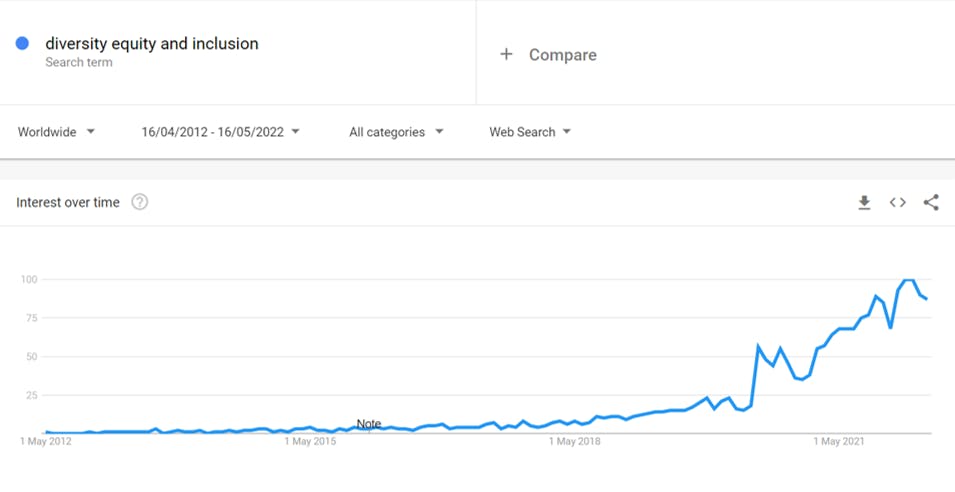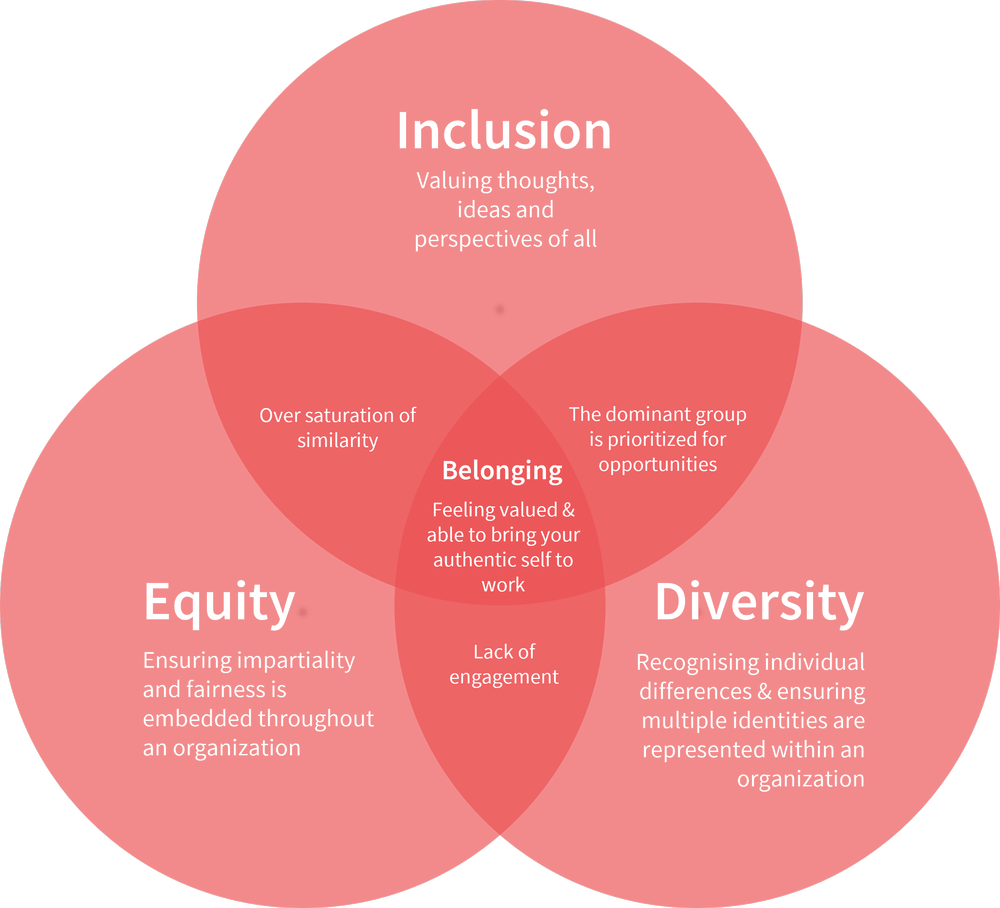Perceptions
What exactly is Diversity Equity and Inclusion and what’s the big deal?
Share
About the Author

What does Diversity, Equity, and Inclusion actually mean, and what’re the benefits of embedding DE&I in your organisation?
You have probably seen the term ‘Diversity, Equity and Inclusion’ or ‘DE&I’ being thrown around over the last 12 months. With over 4000 Google searches worldwide in the last 12 months, DE&I has become a hot topic of discussion, and the number one growing concern amongst HR managers [1]. You may have seen this topic be referred to as ‘D&I’ or ‘EDI’, or other variations, and despite the new buzz around these terms, there appears a lack of clarity around what each of the ‘diversity’, ‘equity’, and ‘inclusion’ terms mean, with them often being used interchangeably. What exactly are the distinctions between each of these terms? And why is DE&I so important for organizations right now?

In short:
- Diversity is the presence of difference that may include protected characteristics such as age and sexuality. In the context of the workplace, this means ensuring that there is representation amongst these different groups.
- Equity is the process of fairness. In the workplace, this includes policies that one would implement to ensure work processes and procedures promote justness and impartiality
- Inclusion is an outcome to ensure that everyone feels and/or is welcomed. As an organisation, you should reflect to assess whether your company is friendly and inviting.
And in a bit more detail…
Diversity
Workplace diversity refers to the range of experiences and characteristics that make up an organisation. Formerly, these characteristics primarily referred to race and ethnicity, whereas now workplace diversity encompasses gender, race, ethnicity, age, sexuality, education, background, and many more. Importantly, diversity is not about viewing everyone as the same, but recognising and understanding people’s differences, and ensuring these are well represented within an organization.

Equity
While diversity focuses on our differences and the representation of this within an organisation, equity refers to the fair treatment of all individuals in spite of these differences. Equity ensures that everyone has equal opportunities to progress and succeed, and it prevents individuals/certain groups from being discriminated against based on characteristics.
Inclusion
A diverse and equitable organisation is one that is well representative of the general public and provides equal access to opportunities for all individuals despite their differences. It may be easy to then assume that all individuals would feel included in a company like this. However, inclusion refers to a sense of belonging and value within an organisation, and it is possible that those even among the most diverse teams, do not always feel included. Inclusion is the act of welcoming, supporting, respecting, and valuing all individuals, and it begins with empathy.
Why is DE&I such a focus for organizations right now?
For many years, companies have considered diversity as something that is nice to have. However, as a result of various intrinsically related social factors, recently there has been a great drive for diversity and inclusion initiatives within organizations. Perhaps one of the most important social variables was the murder of George Floyd in May 2020. The brutal attack on the unarmed African American man by a Minnesota police officer sparked outrage worldwide, leading to a global movement.
What initially started as protests and people sharing their experiences quickly developed into organisations responding with tangible initiatives to address injustices. For instance, Nike reversed its “Just Do It.” slogan to “For once, Don’t Do It.”, meaning “Don’t” pretend there is not a racism problem in America. Furthermore, some businesses came forward with financial pledges and promises of funding for initiatives fighting racial inequality, such as the Bank of America’s $1 billion. Moreover, research started highlighting racial inequality issues at large, such as 70% of ethnic minority workers in the UK reporting experiencing racial harassment at work in the last 5 years [2], and the just 0.8% of Fortune 500 CEOs that are black [3].
Off the back of this movement, organizations started to analyse their own culture and policies and they started implementing new initiatives to tackle diversity and inequality issues within their own teams. This implementation, in addition to the introduction and rise of flexible and remote working during the pandemic, enabled many workforces across the world to become more inclusive for underrepresented groups, not just in terms of race, but also for people with disabilities, and parents of young children.
What are the benefits of DE&I?
Over the last few years, there has been a great push for DE&I initiative among many organisations worldwide. Not only is creating an environment that is inclusive to employees of all genders, backgrounds, and ethnicities, the morally correct thing to do, but research has started emerging highlighting the organisational benefits of having diversity and inclusive teams. As such, it has been found that companies with high levels of diversity have:
- Increased employee engagement: When companies foster a more inclusive work environment, 83% of Millennials are found to be actively engaged in their work [4].
- Higher levels of creativity: Companies in the top quartile for gender diversity on executive boards are 27% more likely to have superior value creation [5].
- Faster problem solving: Mixed teams outperformed individual decision-makers up to 87% of the time, making decisions in ½ the time, with ½ the meetings [6].
- Increased innovation: Companies with above-average total diversity had 19% higher innovation revenues on average [7].
- A boost in company reputation
- Financial benefits: Companies high in racial and ethnic diversity are 35% more likely to have financial returns above the national industry median [8], and companies high in gender diversity are 25% more likely to have above-average profitability [9].
While DE&I has rapidly gained attention over recent years, it is important that we continue the momentum building to ensure that organisations are not just going through the motions, treating diversity as a tick box exercise. Diversity, Equity, and Inclusion is an ongoing process that requires constant commitment and re-evaluation.